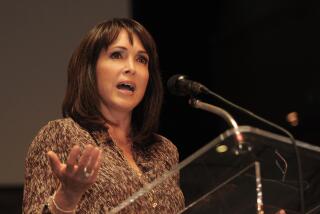The Big Challenge: Fine-Tuning KABC-AM
- Share via
Struggling talk radio staple KABC-AM (790) may be in for a make-over of Madonna-sized proportions. Just because the station doesn’t play pop music doesn’t mean it can’t take a cue from the queen of reinvention, says its recently named program director Erik Braverman.
“It’s a matter of staying in touch with what the times are telling you, as Madonna has been so adept at doing,” said Braverman, who, at 30, is a 13-year talk radio veteran who has been an on-air reporter, a producer and programmer. “You have to evolve.”
Executives at Disney-owned KABC have reason to be introspective. The station finished the recent Arbitron ratings for January through March with its worst showing in 40 years, a 1.9 share of the listening audience.
By May, soon after the numbers were released, KABC’s program director of two years, Drew Hayes, left. His departure followed a series of on-air shake-ups this spring--liberal comic Stephanie Miller was ousted over “creative differences” (“I was creative, they weren’t,” she said on her way out), and conspiracy theorist and late-night host Art Bell retired. Radio talk show veteran Michael Jackson, now at competitor KRLA-AM (1100), had made an exit shortly after Hayes arrived.
Braverman, who has been at KABC four years and in his new job a few days, says “everything is under review. There’s no magic formula to fix a radio station. You need to use your research and your gut, and combine it with good programming and talent.”
*
It’s still to be decided what changes might take place in the station’s talent or program lineup, but Braverman said the tweaking will begin before the fall Arbitron ratings. Marketing, both on- and off-air, will intensify around that time, aiming at the core 35-to-64-year-old AM talk radio listener.
On the talent side, mainstays Larry Elder and Dennis Prager, the station’s top-rated personalities, will remain at the center of the lineup. Other strong performers likely to stay: Al Rantel, Mr. KABC (Marc Germain) and John Kobylt and Ken Chiampou (“The John & Ken Show”).
As a first step in trying to reverse the slide in listeners, the station’s on-air promotional spots have been revamped, dropping their former self-effacing, tongue-in-cheek approach and adopting a no-nonsense tact that emphasizes history and reliability.
The image campaign was created after KABC’s recently conducted research project found that listeners associate the station with a balance of opinion and informed on-air personalities, said Braverman, who heads research for KABC and its sister stations Radio Disney and KLOS-FM (95.5), an area he will keep under his purview.
“So many people grew up [listening to] this station,” Braverman said. “They knew they could hear the latest news, they’d hear from newsmakers and community leaders, and they’d get dialogue from all points of view. We’ll respect and embrace that history.”
There is much for the station to overcome. KABC, whose line-up includes talk stalwart Paul Harvey, Web maven Matt Drudge and feminist attorney Gloria Allred, faces its most keen competition from the nearly dozen other talk stations available in Los Angeles, whose hosts range from local talent to the big syndicated powerhouses such as Howard Stern, Don Imus, Dr. Laura and Rush Limbaugh. Its chief rival is top-rated talk station KFI-AM (640), with a 3.5 share of the listening audience, or roughly 60,000 listeners per quarter hour in the most recent ratings period, almost double KABC’s average of 33,200.
*
While other AM radio is the most direct competition, Braverman also sees TV news as a threat, and a bigger one than the Internet, which he says can complement radio because people often use both media concurrently.
Another major challenge: good times.
With a strong economy, low unemployment and optimistic consumers, there isn’t as much demand for talk radio these days as there was in years past. But the genre still has a place, says Braverman, who started in sports talk when he was a 17-year-old high school junior in his native Houston.
“Listeners aren’t quite as angry as they were in the late ‘80s and early ‘90s,” Braverman said. “But large numbers of people still use talk radio to become informed, because they might not have time to read the papers or watch the news everyday. They also turn to it for entertainment, and we can’t forget that’s part of our mission.”
Though he will aim for a dramatic turnaround, Braverman says it can’t happen overnight. “It’s not like an accounting job where you have to go from red to black in six months,” he said. “It’s much more subjective. The question we’ll keep having to ask is, ‘Are we on the right track?’ ”
More to Read
The complete guide to home viewing
Get Screen Gab for everything about the TV shows and streaming movies everyone’s talking about.
You may occasionally receive promotional content from the Los Angeles Times.






